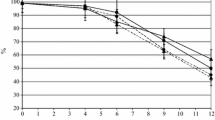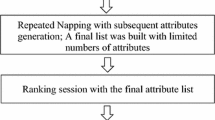Abstract
The effect of pure and mixed culture fermentations by Saccharomyces cerevisiae and Metschnikowia pulcherrima or Torulaspora delbrueckii on physicochemical and sensory qualities of the mango wines were investigated under laboratory conditions. S. cerevisiae produced alcohol at 11.9% from sugar, while one M. pulcherrima and two T. delbrueckii strains (NCIM and IIHR) produced alcohol at 3.8, 7.2 and 6.9% (v/v) in their mono-cultures, respectively. However, in their co-fermentation, they produced similar alcohol content to that of S. cerevisiae mono-culture: 11.04, 11.53, 11.35% (v/v) for S. cerevisiae + M. pulcherrima and S. cerevisiae + T. delbrueckii strains (NCIM and IIHR), respectively. The formation of major volatile compounds in mango wine was assessed by gas chromatography and the analysis showed that the wines from mixed cultures presented differences in the concentration of volatiles. Further, the wines produced by co-fermentation indicated that these non-Saccharomyces strains could be used with S. cerevisiae starter cultures to increase glycerol ranging from 5.4 to 7.6 and to reduce volatile acidity from 1.28 to 0.18 as well as the total acidity from 5.5 to 3.8 (g/l) of the final wines. These characteristics positively influenced the sensory qualities of the wines produced with mixed cultures, which was reflected in the preferences of these wines by panelists. The results emphasized the potential of employing indigenous non-Saccharomyces yeast strains for the production of mango wines with improved flavor.




Similar content being viewed by others
References
Anthony JC (1984) Malt beverages and malt brewing materials: gas chromatographic determination of ethanol in beer. J Assoc Annal Chem 67:192–193
Barbe JC, de Revel G, Joyeux A, Lonvaud-Funel A, Bertrand A (2000) Role of carbonyl compounds in SO2 binding phenomena in musts and wines from botrytized grapes. J Agric Food Chem 48:3413–3419
Bely M, Stoeckle P, Masneuf-Pomarède I, Dubourdieu D (2008) Impact of mixed Torulaspora delbrueckii-Saccharomyces cerevisiae culture on high-sugar fermentation. Int J Food Microbiol 122:312–320
Bisson LF, Kunkee RE (1991) Microbial interactions during wine production. In: Zeikus JG, Johnson EA (eds) Mixed cultures in biotechnology. McGraw-Hill, New York, pp 39–68
Ciani M, Ferraro L (1998) Combined use of immobilized Candida stellata cells and Saccharomyces cerevisiae to improve the quality of wines. J Appl Microbiol 85:247–254
Ciani M, Maccarelli F (1998) Oenological properties of non-Saccharomyces yeasts associated with wine-making. World J Microbiol Biotechnol 14:199–203
Ciani M, Picciotti G (1995) The growth kinetics and fermentation behavior of some non-Saccharomyces yeasts associated with wine-making. Biotechnol Lett 17:1247–1250
Ciani M, Beco L, Comitini F (2006) Fermentation behavior and metabolic interactions of multistarter wine yeast fermentations. Int J Food Microbiol 108:239–245
Ciani M, Comitini F, Mannazzu I, Domizio P (2010) Controlled mixed culture fermentation: a new perspective on the use of non-Saccharomyces yeasts in winemaking. FEMS Yeast Res 10:123–133
Combina M, Elia A, Mercado L, Catania C, Ganga A, Martinez C (2005) Dynamics of indigenous yeast populations during spontaneous fermentation of wines from Mendoza Argentina. Int J Food Microbiol 99:237–243
Dias DR, Schwan RF, Freire ES, Serodio RD (2007) Elaboration of a fruit wine from cocoa (Theobroma cacao L.) pulp. Int J Food Sci Technol 42:319–329
Dufour JP, Malcorps P (1995) Esters synthesis during fermentation: enzyme characterisation and modulation mechanism. In: Campbell I, Priest FG (eds) Proceedings of the fourth aviemore conference on malting. The Institute of Brewing, London, pp 137–151
Etievant PX (1991) Wine. In: Maarse H (ed) Volatile compounds in food and beverages. Marcel Dekker, New York, pp 483–546
Fleet GH, Heard GMY (1993) Growth during fermentation. In: Fleet GH (ed) Wine microbiology and biotechnology. Harwood, Chur, Switzerland, pp 27–54
Fleet GH, Lafon-Lafourcade S, Ribereau-Gayon P (1984) Evolution of yeasts and lactic acid bacteria during fermentation and storage of Bordeaux wines. Appl Env Microbiol 48:1034–1038
Gil JV, Mateo JJ, Jimenez M, Pastor A, Huerta T (1996) Aroma compounds in wines as influenced by apiculate yeasts. J Food Sci 61:1247–1249
Herraiz T, Reglero G, Herraiz M, Martin-Alvarez PJ, Cabezudo M (1990) The influence of the yeast and type of culture on the volatile composition of wine fermented without sulphur dioxide. Am J Enol Vitic 41:313–318
Jolly NP, Augustyn OPH, Pretorius IS (2003) The use of Candida pulcherrima in combination with Saccharomyces cerevisiae for the production of Chenin blanc wine. S Afr J Enol Vitic 24:63–69
Kumar YS, Prakasam RS, Reddy OVS (2009) Optimisation of fermentation conditions for mango (Mangifera indica L.) wine production by employing response surface methodology. Int J Food Sci Technol 44:2320–2327
Kunkee R, Amerine M (1970) Yeast in winemaking. In: Rose AH, Harrison JS (eds) The yeasts. Yeast technology, vol 3. Academic, London, pp 5–72
Lee PR, Ong YL, Yu B, Curran P, Liu SQ (2010) Profile of volatile compounds during papaya juice fermentation by a mixed culture of Saccharomyces cerevisiae and Williopsis saturnus. Food Microbiol. doi:10.1016/j.fm.2010.05.010
Mendoza LM, Manca de Nadra MC, Farias ME (2007) Kinetics and metabolic behavior of a composite culture of Kloeckera apiculata and Saccharomyces cerevisiae wine related strains. Biotechnol Lett 29:1057–1063
Parapouli M, Hatziloukas E, Drainas C, Perisynakis A (2010) The effect of debina grapevine indigenous yeast strains of Metschnikowia and Saccharomyces on wine flavor. J Ind Microbiol Biotechnol 37:85–93
Querol A, Barrio E, Ramon D (1994) Population dynamics of natural Saccharomyces strains during wine fermentation. Int J Food Microbiol 21:315–323
Reddy LVA, Reddy OVS (2005) Production and characterization of wine from mango fruit (Mangifera indica L). World J Microbiol Biotechnol 21:1345–1350
Rodriguez ME, Lopes CA, Barbagelata RJ, Barda NB, Caballero AC (2010) Influence of Candida pulcherrima Patagonian strain on alcoholic fermentation behaviour and wine aroma. Int J Food Microbiol 138:19–25
Rodríguez ME, Lopes CA, Broock MV, Vallés S, Caballero AC (2007) Selection and preliminary characterization of β-glycosidases producer Patagonian wild yeasts. Enzyme Microbial Technol 41:812–820
Romano P, Fiore C, Paraggio M, Caruso M, Capece A (2003) Function of yeast species and strains in wine flavour. Int J Food Microbiol 86:169–180
Simpson RF (1979) Some important aroma components of white table wine. Food Technol Austral 31:518–522
Soden A, Francis IL, Oakey H, Henschke PA (2000) Effects of co-fermentation with Candida stellata and Saccharomyces cerevisiae on the aroma and composition of chardonnay wine. Aust J Grape Wine Res 6:21–30
Sommer P, Bunte A, Stolpe E, Kaldahl P (2007) Flavour enhancement by use of mixed yeast starter cultures of Torulaspora delbrueckii, Kluyveromyces thermotolerans and Saccharomyces cerevisiae in wine. 8th International Symposium Innovations in Enology, Stuttgart, pp. 282–283
Sumby KM, Grbin PR, Jiranek V (2010) Microbial modulation of aromatic esters in wine: current knowledge and future prospects. Food Chem 121:1–16
Suresh ER, Onkarayya H, Ethiraj S (1982) A note on the yeast flora associated with fermentation of mango. J App Bacteriol 52:1–4
Viana F, Gil JV, Genoves S, Vallés S, Manzanares P (2008) Rational selection of non-Saccharomyces wine yeasts for mixed starters based on ester formation and enological traits. Food Microbiol 25:778–78
Xu Y, Zhao GA, Wang LP (2006) Controlled formation of volatile components in cider making using a combination of Saccharomyces cerevisiae and Hanseniaspora valbyensis yeast species. J Ind Microbiol Biotechnol 33:192–196
Zohre DE, Erten H (2002) The influence of Kloeckera apiculata and Candida pulcherrima yeasts on wine fermentation. Process Biochem 38:319–324
Zott K, Miot-Sertier C, Claisse O, Lonvaud-Funel A, Masneuf-Pomarede I (2008) Dynamics and diversity of non-Saccharomyces yeasts during the early stages in winemaking. Int J Food Microbiol 125:197–203
Acknowledgements
This work was financially supported by CSIR, New Delhi, India. Mr. S.Varakumar and Mr. K. Naresh acknowledge the award of SRF by CSIR and JRF by BRNS, respectively. The authors profusely thank Dr. T.N.Bhavanishankar, Plant Manager, Bacardi-Martine India Limited, for providing the GC facility. Special thanks are due to Dr. S.C. Basappa, formerly Dy. Director and Scientist, (CFTRI), Mysore, for his encouragement and critical comments on the manuscript.
Author information
Authors and Affiliations
Corresponding author
Rights and permissions
About this article
Cite this article
Sadineni, V., Kondapalli, N. & Obulam, V.S.R. Effect of co-fermentation with Saccharomyces cerevisiae and Torulaspora delbrueckii or Metschnikowia pulcherrima on the aroma and sensory properties of mango wine. Ann Microbiol 62, 1353–1360 (2012). https://doi.org/10.1007/s13213-011-0383-6
Received:
Accepted:
Published:
Issue Date:
DOI: https://doi.org/10.1007/s13213-011-0383-6




